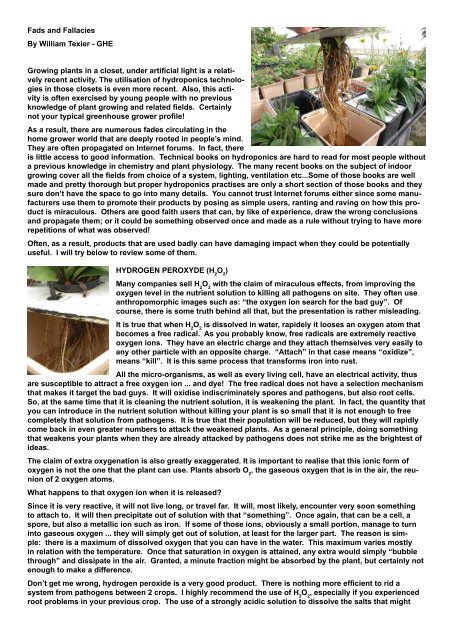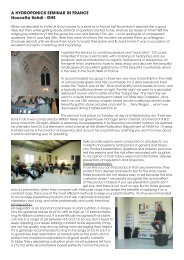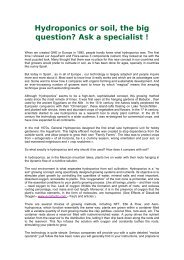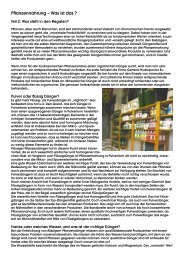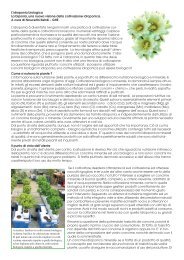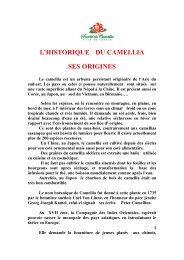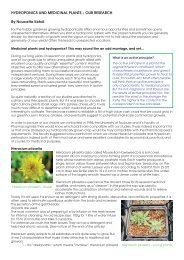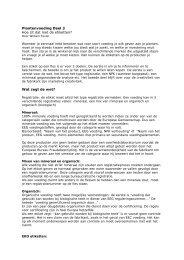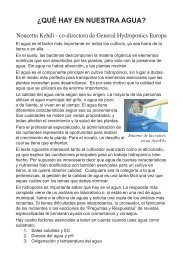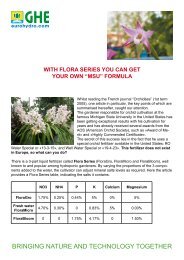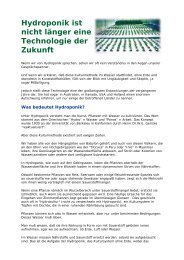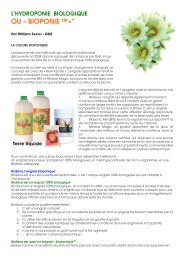Fads and Fallacies By William Texier - General Hydroponics Europe
Fads and Fallacies By William Texier - General Hydroponics Europe
Fads and Fallacies By William Texier - General Hydroponics Europe
You also want an ePaper? Increase the reach of your titles
YUMPU automatically turns print PDFs into web optimized ePapers that Google loves.
<strong>Fads</strong> <strong>and</strong> <strong>Fallacies</strong><br />
<strong>By</strong> <strong>William</strong> <strong>Texier</strong> - GHE<br />
Growing plants in a closet, under artificial light is a relatively<br />
recent activity. The utilisation of hydroponics technologies<br />
in those closets is even more recent. Also, this activity<br />
is often exercised by young people with no previous<br />
knowledge of plant growing <strong>and</strong> related fields. Certainly<br />
not your typical greenhouse grower profile!<br />
As a result, there are numerous fades circulating in the<br />
home grower world that are deeply rooted in people’s mind.<br />
They are often propagated on Internet forums. In fact, there<br />
is little access to good information. Technical books on hydroponics are hard to read for most people without<br />
a previous knowledge in chemistry <strong>and</strong> plant physiology. The many recent books on the subject of indoor<br />
growing cover all the fields from choice of a system, lighting, ventilation etc...Some of those books are well<br />
made <strong>and</strong> pretty thorough but proper hydroponics practises are only a short section of those books <strong>and</strong> they<br />
sure don’t have the space to go into many details. You cannot trust Internet forums either since some manufacturers<br />
use them to promote their products by posing as simple users, ranting <strong>and</strong> raving on how this product<br />
is miraculous. Others are good faith users that can, by like of experience, draw the wrong conclusions<br />
<strong>and</strong> propagate them; or it could be something observed once <strong>and</strong> made as a rule without trying to have more<br />
repetitions of what was observed!<br />
Often, as a result, products that are used badly can have damaging impact when they could be potentially<br />
useful. I will try below to review some of them.<br />
HYdrOGen perOxYde (H 2 O 2 )<br />
Many companies sell H O with the claim of miraculous effects, from improving the<br />
2 2<br />
oxygen level in the nutrient solution to killing all pathogens on site. They often use<br />
anthropomorphic images such as: “the oxygen ion search for the bad guy”. Of<br />
course, there is some truth behind all that, but the presentation is rather misleading.<br />
It is true that when H O is dissolved in water, rapidely it looses an oxygen atom that<br />
2 2<br />
becomes a free radical. As you probably know, free radicals are extremely reactive<br />
oxygen ions. They have an electric charge <strong>and</strong> they attach themselves very easily to<br />
any other particle with an opposite charge. “Attach” in that case means “oxidize”,<br />
means “kill”. It is this same process that transforms iron into rust.<br />
All the micro-organisms, as well as every living cell, have an electrical activity, thus<br />
are susceptible to attract a free oxygen ion ... <strong>and</strong> dye! The free radical does not have a selection mechanism<br />
that makes it target the bad guys. It will oxidise indiscriminately spores <strong>and</strong> pathogens, but also root cells.<br />
So, at the same time that it is cleaning the nutrient solution, it is weakening the plant. In fact, the quantity that<br />
you can introduce in the nutrient solution without killing your plant is so small that it is not enough to free<br />
completely that solution from pathogens. It is true that their population will be reduced, but they will rapidly<br />
come back in even greater numbers to attack the weakened plants. As a general principle, doing something<br />
that weakens your plants when they are already attacked by pathogens does not strike me as the brightest of<br />
ideas.<br />
The claim of extra oxygenation is also greatly exaggerated. It is important to realise that this ionic form of<br />
oxygen is not the one that the plant can use. plants absorb O , the gaseous oxygen that is in the air, the reu-<br />
2<br />
nion of 2 oxygen atoms.<br />
What happens to that oxygen ion when it is released?<br />
Since it is very reactive, it will not live long, or travel far. It will, most likely, encounter very soon something<br />
to attach to. It will then precipitate out of solution with that “something”. Once again, that can be a cell, a<br />
spore, but also a metallic ion such as iron. If some of those ions, obviously a small portion, manage to turn<br />
into gaseous oxygen ... they will simply get out of solution, at least for the larger part. The reason is simple:<br />
there is a maximum of dissolved oxygen that you can have in the water. This maximum varies mostly<br />
in relation with the temperature. Once that saturation in oxygen is attained, any extra would simply “bubble<br />
through” <strong>and</strong> dissipate in the air. Granted, a minute fraction might be absorbed by the plant, but certainly not<br />
enough to make a difference.<br />
don’t get me wrong, hydrogen peroxide is a very good product. There is nothing more efficient to rid a<br />
system from pathogens between 2 crops. I highly recommend the use of H 2 O 2 , especially if you experienced<br />
root problems in your previous crop. The use of a strongly acidic solution to dissolve the salts that might
accumulate in the line, as well as using a strong solution of H 2 O 2 to get rid<br />
of pathogens should be your routine practice between crops. It is only the<br />
idea of using it with plants in the system, that makes the hair on my neck<br />
curl backward!<br />
CO TAbS<br />
2<br />
There is no doubt that bringing extra CO in the atmosphere surrounding<br />
2<br />
your plants will improve their growth, their health, <strong>and</strong> the yield of your<br />
crop. It is not easy to do when growing in a small space: the heat from the<br />
light forces a quasi-constant renewal of the air, making it less practical to<br />
introduce CO . 2<br />
CO tabs serve a good purpose since they release in the growing space a<br />
2<br />
large amount of CO in a short time. Therefore, it is possible to shut the<br />
2<br />
ventilation down for just a little while, but not long enough for the air to become<br />
too hot. And this can be repeated a few times for more effect. However,<br />
it is a bad mistake to put the tabs in your nutrient tank. They must be<br />
dissolved in a separate bucket with no connection what so ever with your<br />
system. You simply do not want CO in your root zone! CO is a by-product of plant metabolism that is re-<br />
2 2<br />
leased by the roots in the nutrient solution, as well as some other molecules exuded by the plants. They are<br />
“polluting” the nutrient solution. A well designed hydroponics system works well for 2 reasons: It oxygenates<br />
the nutrient solution, but also, it helps dissipate the gazes out of solution.<br />
CO tabs are absolutely counter productive in the root zone.<br />
2<br />
It is definitely a good idea to use them, but do take the extra pain of an extra container.<br />
Another good way to bring CO is the slow release system that will bring a slow increase of CO at all times,<br />
2 2<br />
by means of a basic chemical reaction. This is also a practical way, low-tech, efficient, <strong>and</strong> it will not pollute<br />
the nutrient solution.<br />
both those low-tech methods, if well used, can save you quite some money. The cost of a CO generator<br />
2<br />
system is not cheap.<br />
enzYmeS<br />
most people are not familiar with the relationship between enzymes <strong>and</strong><br />
bacteria. In fact the difference is pretty big: bacteria are alive, <strong>and</strong> enzymes<br />
are produced by bacteria, as part of their metabolism. They are the<br />
weapons of bacteria. Their role is to break down dead matter into single<br />
elements on which bacteria can feed. enzymes are short lived but bacteria<br />
produce them all the time. Therefore, during a crop, if you introduce<br />
bacteria, it is like introducing millions of enzyme factories that are going<br />
to work for all the duration of the crop. If well managed, it is obviously<br />
more efficient than introducing enzymes during the crop; at best, a quick<br />
action that will not last very long.<br />
Beneficial fungi growing<br />
in the BioFilter<br />
enzymes are very useful in fact, when used properly, <strong>and</strong> this is in between crops, when you need to clean a<br />
substrate from the residues of the previous crop <strong>and</strong> you want a quick, strong effect. In that case, nothing<br />
better than enzymes! For the rest of the time, use bacteria or fungi (they are also enzyme factories!). The typical<br />
bacteria to use in this case is Trichoderma harzianum, an especially efficient <strong>and</strong> economical product.<br />
We have seen with those few examples how useful products can be detrimental when used improperly. many<br />
beginners tend to buy all the products on the shelf <strong>and</strong> hope that this will help them succeed in their growing<br />
operation. In fact, it is often the contrary. As strange as it might sound, I have seen many beginners fail just<br />
by doing too much. It is better to start just with the basics: a hydroponics system, a plant, a nutrient, <strong>and</strong> a<br />
pH corrector. This is all you need really. From there, you can start experimenting with the many products on<br />
the market today... but not before learning how to use them efficiently!<br />
For more information, don’t hesitate to contact tech@eurohydro.com


